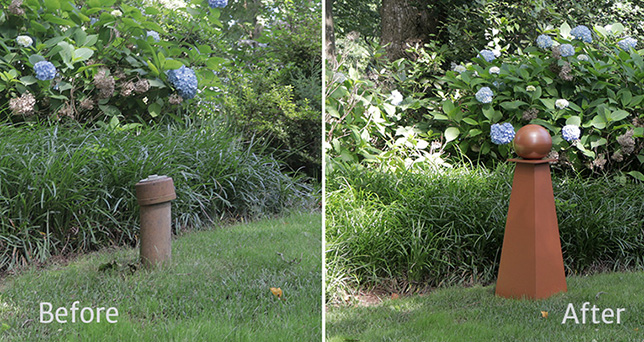You’ve dreamed, you’ve planned and you’ve planted. You’ve watered, mulched, and mowed. Your grass is lush and green, your beds and borders vibrant, and your walkways and patio an elegant tapestry in stone. Yet each time you look out the window to admire your grand design, there’s that one thing….that one permanent disfigurement that constantly draws your gaze. Oh, how you hate that unsightly sewer pipe (or well pump, air conditioning unit, heat pump, transformer, cable box, trash cans--take your pick)! But what can you do?
Never fear—you don’t have to let that nightmare ruin your dream! There are creative ways to hide those outdoor eyesores--without redesigning your entire landscape--using vine-covered garden structures or benches, shrubs, or a decorative cover. A few simple rules will help you plan for the best solution:
- Keep it accessible—Sometime, someone will need to get to that thing, or it wouldn’t be there in the first place. Consider a plant’s mature growth, and place accordingly. Make sure trellises or other structures are removable, or placed far enough away to allow proper access.
- Keep it safe—air conditioning units need ventilation on all sides of the unit, so it’s not advisable to plant closer than a foot or two, and don’t use a solid cover. Lattice is a better choice. Also, be careful of wires if you’re planting near electrical or cable boxes. Wires may be much less deep than you think!
- Check with your utility company—You don’t want to accidentally run into any wires or pipes, and most utility companies require you to notify them before you dig. They will mark the lines for you so you don’t run into trouble. The rule of thumb when planting near transformers on concrete pads is 3 feet of clearance on the sides, 1 foot clearance behind, and 10 feet in the front where the box opens, but it’s best to know for sure.
Trellises, pillars, and obelisks are simple to install and can accommodate a variety of plants for sun or shade. A classic black steel trellis will suit most landscapes, and be sturdy as well as decorative. It also provides a nice backdrop for a birdbath or statuary.
A rose pillar or obelisk may provide enough camouflage, and be a lovely garden accent as well. In a large yard, an attractive arrangement might be 3 different sized pillars, or an obelisk and two trellises planted in a triangle around the offending object, such that the trellises provide a backdrop for the obelisk from the predominant view.
A garden bench with a back is a good choice for disguising one side, with trellises, pillars, and /or plantings hiding the other sides. Choose a lightweight wooden or metal bench rather than a heavy concrete bench, so that it can be pulled out for access.
A bench in front of a trio of graceful tall grasses surrounding the object would do the trick nicely, requiring a minimum of effort and upkeep.
A bower is an excellent choice, as the pipe or box could be hidden between the bench and the bower while remaining accessible. And who wouldn't enjoy a quiet nook in the garden for morning coffee or weekend reading?
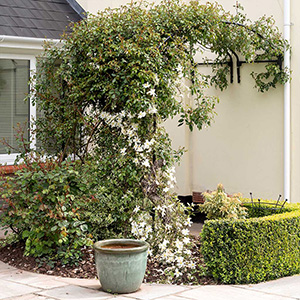
To conceal an air conditioning unit, or even your trash can storage, consider a wall arch to cover one side. Patio Feet are available for our Agriframes wall arches, which enable installing on a deck or patio. Disguise the remaining sides as needed with shrubs, or large planters like our lightweight Fiberstone planters. A mix of sizes is often more aesthetically pleasing than a "wall" of identical planters.
A simple screen can be made by connecting wooden trellis sections of the appropriate height with hinges or cable ties. For additional stability, they can be nailed or stapled to 2x4 lumber on the inside at the bottom. Hooks specially made for vinyl siding make it easy to attach a 3-sided screen to the house--just loop a piece of twine or cable tie through the trellis at the edge, and run the loop through the hook. If you don't want to drill for hooks or brackets into brick or stucco walls, then rebar can be installed next to the walls and the screen attached with cable ties on one side and twine or carabiner clips on the other. This will make for easy access on trash day, or (don't say it!) in the event your a/c unit needs to be serviced.
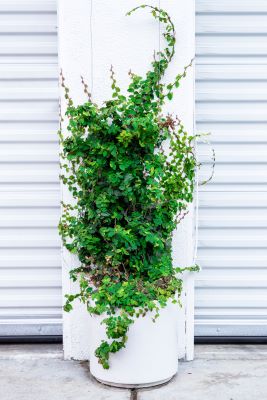
Painting the screen the same color as the house will make it virtually disappear. This homeowner constructed a solid box to cover an electric meter, and added a pot in the same color in which to grow a clinging plant. Notice how the box and pot fade into the house, with the plant drawing all the attention.
The other advantage to this design is that the entire arrangement may be pulled away when access is necessary. However, a clinging vine, such as the euonymous used here, is not essential. (Warning: spreading euonymous species are considered invasive in many parts of the country. When encouraged to grow upward rather than spreading, the likelihood that they will flower and produce seed increases, so even when grown in a container there is still an opportunity for this plant to find its way into the environment.) Any attractive plant with good foliage cover from top to bottom that is root-hardy in your winters would work.
Alternatively, a small trellis or obelisk on which to grow a vine could be placed in the pot.
Numerous attractive long-flowering vines may be grown on lattice or trellises—roses and clematis are popular choices. Twining vines and roses will do fine on more open trellises. Vines that attach with delicate tendrils will appreciate wire lattice to assist their ascent .
You may wish to choose an evergreen vine that will provide more coverage during winter. English ivy is a popular choice, but will easily root into adjacent lawn areas and is invasive, especially if allowed to fruit. If this is indeed your choice, you must be prepared to contain it to protect your landscape and the environment. I've found that surrounding it with edging that sticks up a few inches above ground leaves a spot to prune that is not rooted into the ground. Check every couple of weeks during growing season, and trim and remove anything that's growing out of bounds. If your ivy matures enough to flower, please remove them before they fruit.
Small evergreen shrubs are commonly used to disguise cable boxes, pipes, and the like. Be sure to choose something that will not outgrow the allotted space, or frequent maintenance will be required to keep the design in scale. Juniper, Japanese holly, and boxwood may fit the bill. For strikingly hued foliage, consider golden arborvitae or chamaecyparis species, or semi-evergreen variegated abelias
or purple lorpetalum.
Ornamental grasses are a good choice, as they grow quickly, yet require only cutting back in late winter. Spreading mounding perennials are ideal for filling in around grasses and shrubs, to aid in disguising an ugly yard pipe. Easily grown choices include hardy geranium, threadleaf coreopsis, catmint, and Artemesia 'Powis Castle.'
A mixture of plants will be more pleasing than hedging the object in with the same plants—perhaps a tall grass on one side, with shorter junipers on the remaining sides. Very stiff appearing evergreens such as some boxwood and Japanese holly may be better on their own, as their more formal look tends not to blend well in a small planting with voluminous grasses and billowy perennials. If you want to use grasses in a more formal planting, choose upright switchgrass or feather reed grass, and leave the flowing maiden and fountain grasses for more casual areas.
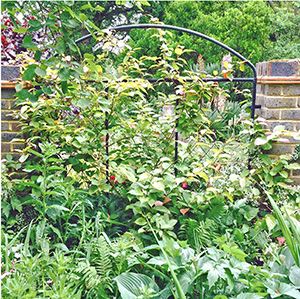
To block large transformers, a mix of the above is often the best tactic. Place a lattice fence section, like our Monet Fencing Panel pictured, on one side, with a mix of shrubs and perennials on the remaining sides. If the problem is at the corner of the yard, echoing that corner with the lattice works well. Try not to have the entire design the same height all the way around--this tends to look unnatural. Place a taller structure or plant at the back, or place the taller items on the two opposing sides.
The side where the box opens must usually have that 10 foot clearance, so one good option is to plant a small tree just that far away on that side of the box. The idea is that something taller than the offending object will draw the eye up and away.
Using a decorative cover is a simple and easy way to conceal yard pipes and cable boxes. You may be able to use a tall, narrow pot turned upside-down, and perhaps place a matching shorter planted pot, or small statuary on top. Alternatively, you could place a large plant saucer on top of the upturned pot for an instant birdbath.
Purchasing a hollow pedestal specifically designed for this purpose, like our Black Column Pedestal, will give you many creative options: top with a sundial, armillary (such as our Sundial Armillary), planted pot, statuary, solar lantern, or bird bath. One of our clever customers needed his pedestal shorter until his tree grew, so he simply buried it a little deeper. Siting the statuary this way is truly striking, giving the piece a museum or art gallery feel.
Design considerations:
- Keep the structures or plantings in scale with the area. If the pipe is in a small garden area, use smaller plants and structures so as not to overwhelm the space. On the other hand, if you are working in a vast lawn area, those smaller items will seem lost and out of place. Keep the overall aesthetic in mind.
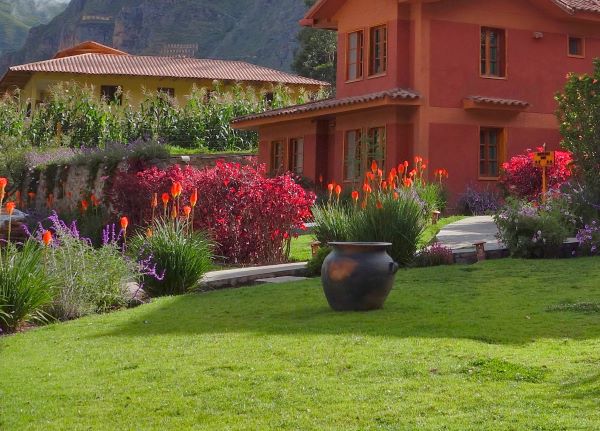 Tie in your new area with the existing design, so it won’t look as if it just dropped out of the sky. Repeat plants or foliage or flower colors from the surrounding beds. If the object is relatively close to a garden bed, it may make sense to reshape the bed to include the new structures or plantings. In the photo to the right, the black pot seems as if someone just couldn't carry it any farther, and that's where it landed. It's too close the the planted areas to be a separate focal point, so the look is disjointed. Connecting the new area to the existing garden bed with a path is a nice idea, especially if you are using a bench or bird bath as one of your features.
Tie in your new area with the existing design, so it won’t look as if it just dropped out of the sky. Repeat plants or foliage or flower colors from the surrounding beds. If the object is relatively close to a garden bed, it may make sense to reshape the bed to include the new structures or plantings. In the photo to the right, the black pot seems as if someone just couldn't carry it any farther, and that's where it landed. It's too close the the planted areas to be a separate focal point, so the look is disjointed. Connecting the new area to the existing garden bed with a path is a nice idea, especially if you are using a bench or bird bath as one of your features.
- Choose the view that is most important to you, but don’t completely forget the other side. While a trellis backdrop to your bench may look good from inside the house, it may look strange from the road. Creating at least one lower level in your design will help soften jarring angles and make your arrangement flow, even if it’s just planting a bit of liriope in front of the trellis as seen from the road.
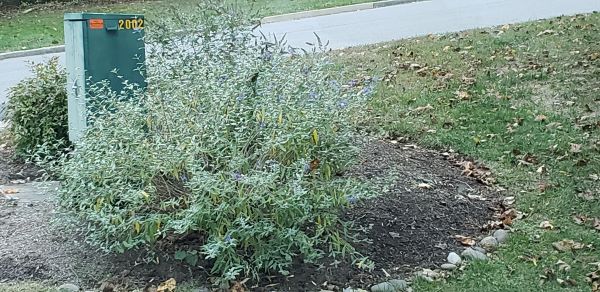
- Don't unwittingly turn your eyesore into an unfortunate focal point, as in this photo. The box in this small bed is the tallest aspect, and centrally located. Unless the offending object can be completely concealed, it should not be smack in the middle, and needs something with more height to focus attention up and away. To correct this planting without reshaping the bed, I would add a taller trellis with vine or narrow evergreen behind the box, and add a groundcover that can tolerate foot traffic in front around the stepping stone, connecting to the other plantings. (This box opens on the unplanted side, so access must not be blocked.) Adding the shorter plants will mitigate the harsh edges, and create a flow that will draw the eye down and around the bed. A small shiny or colorful garden ornament on one side of the bed would further divert attention lower and away.
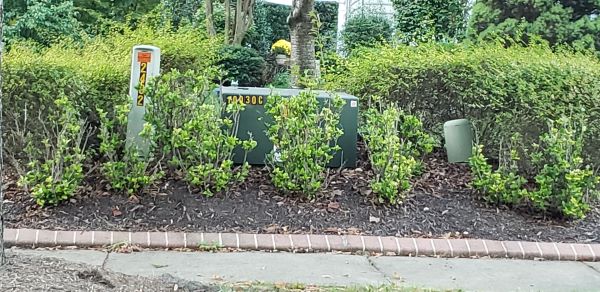
I found this unfortunate homeowner who got stuck with an entire row of assorted utility boxes in their front yard. They've tried, but either they've pruned the bushes hard because they chose something that gets too large in the first place, or the plants have suffered dieback on their own--maybe both. The stiff nature of the planting actually calls more attention to what they don't want to you to see. Instead, a 3 foot tall grass in front of each round box and one behind the central box would soften and draw the eye up. Coneflowers or black-eyed Susans would hide the front of the box, and could be repeated on either side of the grasses. This type of planting is much easier to maintain. If the look of the box in winter after the flowers have gone dormant is really too bothersome, a piece of lattice could be installed to hide it.
Hopefully, these tips will help you bring out the best in your landscape and remove those unsightly distractions. Myriad possibilities await. Who knows, while simply trying to hide an outdoor eyesore you may end up creating the most beautiful spot in your garden!


